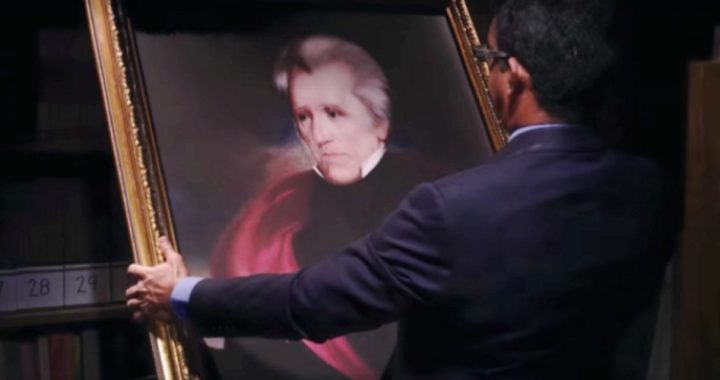
Hillary’s America — The Secret History of the Democratic Party is the third installment of Dinesh D’Souza’s politically oriented movies. While D’Souza’s latest cinematic enterprise contains much that is very good, including the making of the connection of both President Barack Obama and presidential nominee Hillary Clinton to radical leftist Saul Alinsky, and their own radical backgrounds, some parts of the movie take great liberties with historical fact.
I suspect that D’Souza, who spent eight months in prison as a result of a clearly politically inspired prosecution because of his 2012 movie documenting the leftist background of Obama, is understandably bitter. But as bad as the modern Democratic Party is, that does not excuse twisting history in an effort to make the Democratic Party totally evil and the Republican Party totally good.
Both political parties have had their moments in history that today’s traditionally minded, small-government conservatives can cite as good; but sadly, with both the Democrats and the Republicans, those moments have been far too brief.
Perhaps D’Souza’s best achievement in this present movie is demonstrating the falsity of the lie that the reason the South switched from Democrat to Republican was due to racism. One of the talking-points of the Democratic Party today is that all the racists and segregationists of the southern Democratic Party moved over into the Republican Party as a result of the passage of the Civil Rights Act of 1964.
Southerners voted against the very liberal Senator George McGovern, the Democratic Party nominee in 1972, along with almost all of the rest of the country. Southerner Jimmy Carter temporarily checked this realignment in 1976, only to lose to Republican Ronald Reagan in the election of 1980. Considering that Reagan carried 44 states, with the help of the so-called Reagan Democrats, in the North, South, East, and West, one must ask: Did almost the entire nation switch in 1980 because of a civil rights law passed 16 years earlier?
Of course, Reagan went on to carry 49 states in 1984. The presidency of Bill Clinton in the 1990s continued this realignment, and by 2000, the switch was mostly complete.
But, whereas progressive Democrats unfairly slander conservative Republicans with the “race card,” D’Souza’s film is even more unfair, unloading the entire deck of race cards on the Democratic Party.
D’Souza’s thesis is that the Democratic Party was essentially founded by Andrew Jackson in the 1820s, and the party has been both racist and evil ever since.
In an effort to advance this thesis, every Democrat in the film is evil and every Republican is cast as heroic. And no man is more evil, at least according to D’Souza’s film, than Andrew Jackson.
While there are many negative things that can fairly be said about Andrew Jackson, D’Souza simply goes too far in his desire to make Jackson the Devil Incarnate. One can certainly disagree with Jackson’s Indian removal policy without presenting him as a hater of Native Americans. Left out of the movie was Jackson’s adoption of a Creek orphan boy, Lyncoya. He and his wife, Rachel, were unable to have children of their own, and they raised the boy at the Hermitage, and paid for his education as a saddle maker. (Jackson’s original desire was to send the boy to West Point, but the young man died in 1828 of tuberculosis.)
But perhaps the most unfair treatment of Jackson was D’Souza’s portrayal of him as forcing slave women to have sex with him. Absolutely zero evidence exists to support such a claim.
D’Souza’s version of Andrew Jackson is more like a comic book villain than reality. When James Parton wrote his three-volume Life of Andrew Jackson on the eve of the Civil War, he interviewed many individuals, still living, who remembered “Old Hickory.”
One of those interviewed was a former slave of Jackson’s named Hannah. She praised him highly, saying he “was more of a father to us than a master, and many’s the time we’ve wished him back again.” She was present in his bedroom when he died in 1845. According to Hannah, as well as several other witnesses, among his last words were, “I hope to meet you all in Heaven, both black and white.”
Other records exist that Jackson could sometimes be cruel to his slaves, but none of these accounts even hint at sexual relationships with them — forced or consensual.
Another historical distortion in the movie involved the caning of Senator Charles Sumner, an ardent abolitionist. The movie portrays Sumner speaking on the floor of the Senate against slavery, when a pro-slavery Democrat from South Carolina, Congressman Preston Brooks, came up behind him and began to strike him with a cane.
No doubt the attack was brutal and unjustifiable. But D’Souza’s version leaves out important facts. In his intemperate speech, Sumner had called for the entire state of South Carolina to be “blotted out of existence,” and had accused their senator, Andrew Butler, of forcible sexual relations with his slaves. He also made fun of Butler’s speech impediment, mocking Butler’s difficulty in speaking. Butler was not on the floor to defend himself, so Brooks crossed over from the House side and launched his savage attack upon Sumner.
Again, brutal and unjustifiable, but D’Souza’s version is altered to make the case that the entire Democratic Party was pro-slavery, in contrast to the pure and heroic Republican Party.
His treatment of Sumner illustrates how D’Souza passes over the failings of the Republican Party. Sumner later joined the First International, or “International Workingmen’s Association,” which was formed by Karl Marx and others in London in 1864. Being a member of the world communist movement is hardly heroic.
Neither political party has ever — at any time in its history — been a good example of dedication to the constitutional principles of limited government, free enterprise, and individual liberty that we would like them to be. In the last quarter of the 19th century, the Democratic Party, if anything, tended to be the more conservative of the two political parties.
The Democratic president Woodrow Wilson, elected in 1912, was justly castigated in D’Souza’s movie as a racist and a segregationist. Wilson was also a “progressive” who worked to undermine the Constitution of the United States and end American national sovereignty with the League of Nations. But, the Republican Theodore Roosevelt was very similar to Wilson — in fact, Roosevelt actually ran for president in 1912 on the “Progressive Party ticket,” a campaign in which he attacked the very idea of “private property.”
Presidents Warren Harding and Calvin Coolidge, both Republicans who served in the 1920s, were certainly much better than either Republican Roosevelt or Democrat Wilson, but they were followed by yet another progressive Republican, Herbert Hoover in 1929. Hoover’s meddling in the economy helped deepen the Great Depression, and even provided a model for the New Deal of Democrat Franklin Roosevelt.
Certainly Republican candidates of the last several decades have tended to sound more conservative than Democrats, but their performance in office has generally not been anything to be happy about, if one is a conservative. Now, if one attends Republican grassroots meetings and Democrat grassroots meetings, there are usually stark differences that one can note. But, at the congressional level, and the presidential level, these differences become much less pronounced.
Perhaps one of the better moments in the movie was when D’Souza interviewed Jonah Goldberg, author of the book Liberal Fascism. Goldberg noted that in the 1920s, American progressives (who later took on the name liberals) heaped praise upon the system of government found in Fascist Italy, under Benito Mussolini. As Goldberg correctly said, the only progress that progressives are making is away from the Constitution and the system of government created by our Founding Fathers. He said that progressivism, liberalism, and socialism are all pretty much the same.
While a person who favors limited government and our constitutional form of government can certainly agree with D’Souza’s indictment of the modern Democratic Party, distortions of history to make that case only hurt the case in the end.
Photo: Dinesh D’Souza holding portrait of Andrew Jackson, from the movie Hillary’s America
Steve Byas is a professor of history at Randall University in Moore, Oklahoma. His book History’s Greatest Libels is a challenge to some of the great distortions of history.



